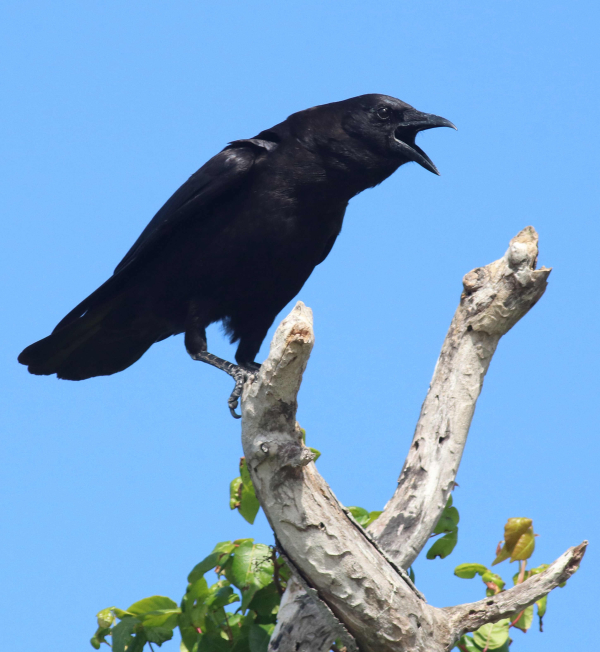
The brain of a crow, such as this Fish Crow, is relatively large compared to its body size.
|
New research suggests that some birds evolved over time to have smaller bodies while maintaining large brains. Researchers studied the skulls belonging to hundreds of dinosaurs and extinct birds by making CT scans of the ancient animals’ skulls to create endocasts, which act like an imprint of the brain cavity within the skull. Then they compared the brain sizes with brain measurements of modern birds in a large data set. Together, evolutionary biologists and paleontologists were able to show a timeline for bird brain evolution, which they recently published in the journal Current Biology.
Before the mass extinction event that killed off dinosaurs 66 million years ago, the researchers discovered that birds and large dinosaurs had brains that were very similar in size. But some birds went through what the researchers refer to as a “scaling” event after the dinosaurs went extinct. Birds were some of the first animals to recover and repopulate the empty landscape after the dinosaurs. They diversified and evolved in this setting, and some of the birds that started out larger in size experienced what is called “scaling down.” That is, their bodies became reduced in size, but they maintained the big brains of their larger ancestors.
Daniel Ksepka, lead author and curator of science at the Bruce Museum in Greenwich, Connecticut wrote, “Our paper emphasizes that the mass extinction really altered the course of avian brain evolution. There were profound changes in brain-body scaling in the immediate aftermath of the extinction, and these may have played an important role in modern birds surviving and going on to radiate into the 10,000-plus species we have today.”
Ksepka noted that they found at least seven brain-body scaling events in birds after the mass extinction of dinosaurs. Before the mass extinction event, the similarities between dinosaur and bird brains were almost indistinguishable. “There is no clear line between the brains of advanced dinosaurs and primitive birds,” said Amy Balanoff, study co-author and assistant research professor in Johns Hopkins University’s Department of Psychological and Brain Sciences. “Birds like Emus and pigeons have the same brain sizes you would expect for a theropod dinosaur of the same body size, and in fact some bird species like the [extinct] Moas had smaller-than-expected brains.”
The mass extinction event likely acted as a trigger for these changes. These birds had to evolve to survive. The largest evolutionary brain leap is evident in modern birds like parrots and corvids – the group that includes crows, ravens, jays, and related birds. Their brains are quite large when compared with their body size, although crows and parrots are relatively large birds. Crows are “particularly turbo-charged” when it comes to brain capacity, Ksepka added.
It can explain why they’re able to recognize and remember human faces, use tools, and even speak as parrots do. “Crows are really off the charts; they outpaced all other birds,” noted Adam Smith, study co-author and curator of the Bob Campbell Geology Museum at Clemson University.
For more information about the new publication about the evolution of bird brains, refer to https://www.cnn.com/2020/04/23/world/bird-brain-sizes-scn/index.html